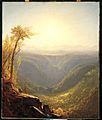Kaaterskill Clove facts for kids
Kaaterskill Clove is a very deep valley, also called a gorge, located in New York's eastern Catskill Mountains. You can find it just west of the village of Palenville and in Haines Falls. This impressive gorge was carved out by Kaaterskill Creek, a stream that flows into Catskill Creek. Experts believe the clove is incredibly old, possibly as much as 1 million years! On one side of the gorge, you'll see Kaaterskill High Peak and Roundtop Mountain. On the other side is South Mountain. Because of these tall mountains, the gorge can be as deep as 2,500 feet in some areas.
Contents
A Look Back: The History of Kaaterskill Clove
We don't know much about Kaaterskill Clove before the year 1817. That's when a man named Gilbert Palen built a tannery near the entrance of the clove. A tannery is a place where animal hides are turned into leather. This tannery gave the nearby village its name: Palenville.
After the War of 1812, people in America were free to trade more easily. Industries across the country grew quickly. Palenville and Kaaterskill Clove became important for tanneries. This was because there were many large hemlock forests in the clove. Hemlock trees were needed for the tanning process.
However, after only about 50 years, too many trees were cut down. This is called deforestation. Without enough trees, the tannery business couldn't continue. So, Palenville changed its focus. It became a town for tourists. People built many guesthouses. The town even said it was the home of the famous fictional character, Rip Van Winkle.
Kaaterskill Clove: A Place for Artists
The clove became a very popular spot for artists and people who loved to walk. They came to escape the busy cities. Artists from the famous Hudson River School especially loved to paint the Clove. For example, Asher Brown Durand painted Kindred Spirits in 1849, showing his friend and artist Thomas Cole there. Sanford Robinson Gifford also painted Kaaterskill Clove in the Catskills in 1862. Jennie Augusta Brownscombe, a founder of the Arts Student's League, even had a studio there.
Later, in the 20th century, artists like Thomas Locker also loved the Clove. He said it was a vacation spot he visited many times since he was a child. Many of his paintings show the Clove and life there.
Getting Around the Clove
Many large hotels and mountain houses were built in the area. These included the Laurel House, the Catskill Mountain House, and the Haines Falls House. People also built trails and walkways to reach the many beautiful viewpoints and waterfalls in the clove.
One very important path was the Rip Van Winkle Trail. Today, this is known as Route 23A. It winds its way up the clove from Palenville to the small community of Haines Falls. This road made it much easier for visitors from the cities to explore the inside of the clove. It is still a main road into the northern Catskills, especially in winter when another road, Route 35, is closed.
Exploring Kaaterskill Clove: Fun Attractions
One of the most famous places in Kaaterskill Clove is Kaaterskill Falls. This is a stunning 231-foot waterfall on Lake Creek. Many people think it's the tallest waterfall in New York State!
There are other waterfalls in the clove too, like Fawn's Leap, Buttermilk Falls, and Haines Falls. However, the old trails to these falls have disappeared over time. This makes them harder to reach now.
Hiking and Views
Kaaterskill Clove has many great hiking trails both inside and above it. The Long Path, a long-distance hiking trail, goes through the clove. It follows along the southern edge.
Trails on the northern edge lead to amazing spots like Inspiration Point, Sunset Rock, and Artist Rock. From these places, you can look down into the clove. You can also see across to Kaaterskill High Peak. There is also a campground near North-South Lakes. You can also visit the spot where the old Catskill Mountain House used to stand. From there, you get incredible views across the Hudson Valley.
Images for kids
-
Painting by Thomas Cole







